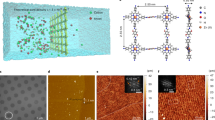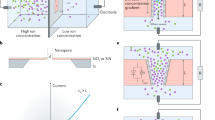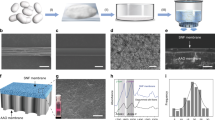Abstract
Making use of the osmotic pressure difference between fresh water and seawater is an attractive, renewable and clean way to generate power and is known as ‘blue energy’1,2,3. Another electrokinetic phenomenon, called the streaming potential, occurs when an electrolyte is driven through narrow pores either by a pressure gradient4 or by an osmotic potential resulting from a salt concentration gradient5. For this task, membranes made of two-dimensional materials are expected to be the most efficient, because water transport through a membrane scales inversely with membrane thickness5,6,7. Here we demonstrate the use of single-layer molybdenum disulfide (MoS2) nanopores as osmotic nanopower generators. We observe a large, osmotically induced current produced from a salt gradient with an estimated power density of up to 106 watts per square metre—a current that can be attributed mainly to the atomically thin membrane of MoS2. Low power requirements for nanoelectronic and optoelectric devices can be provided by a neighbouring nanogenerator that harvests energy from the local environment8,9,10,11—for example, a piezoelectric zinc oxide nanowire array8 or single-layer MoS2 (ref. 12). We use our MoS2 nanopore generator to power a MoS2 transistor, thus demonstrating a self-powered nanosystem.
This is a preview of subscription content, access via your institution
Access options
Subscribe to this journal
Receive 51 print issues and online access
$199.00 per year
only $3.90 per issue
Buy this article
- Purchase on Springer Link
- Instant access to full article PDF
Prices may be subject to local taxes which are calculated during checkout




Similar content being viewed by others
References
Logan, B. E. & Elimelech, M. Membrane-based processes for sustainable power generation using water. Nature 488, 313–319 (2012)
Pattle, R. Production of electric power by mixing fresh and salt water in the hydroelectric pile. Nature 174, 660 (1954)
Loeb, S. Osmotic power-plants. Science 189, 654–655 (1975)
van der Heyden, F. H., Stein, D. & Dekker, C. Streaming currents in a single nanofluidic channel. Phys. Rev. Lett. 95, 116104 (2005)
Siria, A. et al. Giant osmotic energy conversion measured in a single transmembrane boron nitride nanotube. Nature 494, 455–458 (2013)
Suk, M. E. & Aluru, N. Water transport through ultrathin graphene. J. Phys. Chem. Lett. 1, 1590–1594 (2010)
Heiranian, M., Farimani, A. B. & Aluru, N. R. Water desalination with a single-layer MoS2 nanopore. Nature Commun. 6, 8616 (2015)
Wang, Z. L. & Song, J. Piezoelectric nanogenerators based on zinc oxide nanowire arrays. Science 312, 242–246 (2006)
Wang, Z. L. Self-powered nanosensors and nanosystems. Adv. Mater. 24, 280–285 (2012)
Tian, B. et al. Coaxial silicon nanowires as solar cells and nanoelectronic power sources. Nature 449, 885–889 (2007)
Xu, S. et al. Self-powered nanowire devices. Nature Nanotechnol. 5, 366–373 (2010)
Wu, W. et al. Piezoelectricity of single-atomic-layer MoS2 for energy conversion and piezotronics. Nature 514, 470–474 (2014)
Liu, K., Feng, J., Kis, A. & Radenovic, A. Atomically thin molybdenum disulfide nanopores with high sensitivity for DNA translocation. ACS Nano 8, 2504–2511 (2014)
Farimani, A. B., Min, K. & Aluru, N. R. DNA base detection using a single-layer MoS2 . ACS Nano 8, 7914–7922 (2014)
Liu, X. et al. Top–down fabrication of sub-nanometre semiconducting nanoribbons derived from molybdenum disulfide sheets. Nature Commun. 4, 1776 (2013)
Feng, J. et al. Electrochemical reaction in single layer MoS2: nanopores opened atom by atom. Nano Lett. 15, 3431 (2015)
Stein, D., Kruithof, M. & Dekker, C. Surface-charge-governed ion transport in nanofluidic channels. Phys. Rev. Lett. 93, 035901 (2004)
Bocquet, L. & Charlaix, E. Nanofluidics, from bulk to interfaces. Chem. Soc. Rev. 39, 1073–1095 (2010)
Lee, C. et al. Large apparent electric size of solid-state nanopores due to spatially extended surface conduction. Nano Lett. 12, 4037–4044 (2012)
Shan, Y. et al. Surface modification of graphene nanopores for protein translocation. Nanotechnology 24, 495102 (2013)
Ge, P. et al. Hydrogen evolution across nano-schottky junctions at carbon supported MoS2 catalysts in biphasic liquid systems. Chem. Commun. 48, 6484–6486 (2012)
Kim, D.-K., Duan, C., Chen, Y.-F. & Majumdar, A. Power generation from concentration gradient by reverse electrodialysis in ion-selective nanochannels. Microfluid. Nanofluidics 9, 1215–1224 (2010)
Vlassiouk, I., Smirnov, S. & Siwy, Z. Ionic selectivity of single nanochannels. Nano Lett. 8, 1978–1985 (2008)
Cao, L. et al. Towards understanding the nanofluidic reverse electrodialysis system: well matched charge selectivity and ionic composition. Energy Environ. Sci. 4, 2259–2266 (2011)
Wu, J., Gerstandt, K., Zhang, H., Liu, J. & Hinds, B. J. Electrophoretically induced aqueous flow through single-walled carbon nanotube membranes. Nature Nanotechnol. 7, 133–139 (2012)
Waduge, P. et al. Direct and scalable deposition of atomically thin low-noise MoS2 membranes on apertures. ACS Nano 9, 7352–7359 (2015)
Surwade, S. P. et al. Water desalination using nanoporous single-layer graphene. Nature Nanotechnol. 10, 459–464 (2015)
Radisavljevic, B., Radenovic, A., Brivio, J., Giacometti, V. & Kis, A. Single-layer MoS2 transistors. Nature Nanotechnol. 6, 147–150 (2011)
Walker, M. I., Braeuninger-Weimer, P., Weatherup, R. S., Hofmann, S. & Keyser, U. F. Measuring the proton selectivity of graphene membranes. Appl. Phys. Lett. 107, 213104 (2015)
Dumcenco, D. et al. Large-area epitaxial monolayer MoS2 . ACS Nano 9, 4611–4620 (2015)
York, D., Evensen, N. M., Martınez, M. L. & Delgado, J. D. B. Unified equations for the slope, intercept, and standard errors of the best straight line. Am. J. Phys. 72, 367–375 (2004)
Ku, H. Notes on the use of propagation of error formulas. J. Res. National Bureau Standards 70C, 263–273 (1966)
Plimpton, S. Fast parallel algorithms for short-range molecular dynamics. J. Comput. Phys. 117, 1–19 (1995)
Hockney, R. W. & Eastwood, J. W. Computer Simulation Using Particles (CRC Press, 1988)
Nosé, S. A unified formulation of the constant temperature molecular dynamics methods. J. Chem. Phys. 81, 511–519 (1984)
Hoover, W. G. Canonical dynamics: equilibrium phase-space distributions. Phys. Rev. A 31, 1695–1697 (1985)
Probstein, R. F. Physicochemical Hydrodynamics: An Introduction. (John Wiley & Sons, 2005)
Nandigana, V. V. & Aluru, N. Understanding anomalous current–voltage characteristics in microchannel–nanochannel interconnect devices. J. Colloid Interface Sci. 384, 162–171 (2012)
Nandigana, V. V. & Aluru, N. Nonlinear electrokinetic transport under combined ac and dc fields in micro/nanofluidic interface devices. J. Fluids Eng. 135, 021201 (2013)
Nandigana, V. V. & Aluru, N. Characterization of electrochemical properties of a micro–nanochannel integrated system using computational impedance spectroscopy (cis). Electrochim. Acta 105, 514–523 (2013)
Weinstein, J. N. & Leitz, F. B. Electric power from differences in salinity: the dialytic battery. Science 191, 557–559 (1976)
Audinos, R. Reverse electrodialysis. Study of the electric energy obtained by mixing two solutions of different salinity. J. Power Sources 10, 203–217 (1983)
Turek, M. & Bandura, B. Renewable energy by reverse electrodialysis. Desalination 205, 67–74 (2007)
Suda, F., Matsuo, T. & Ushioda, D. Transient changes in the power output from the concentration difference cell (dialytic battery) between seawater and river water. Energy 32, 165–173 (2007)
Veerman, J., De Jong, R., Saakes, M., Metz, S. & Harmsen, G. Reverse electrodialysis: comparison of six commercial membrane pairs on the thermodynamic efficiency and power density. J. Membr. Sci. 343, 7–15 (2009)
Acknowledgements
This work was financially supported by the European Research Council (grant 259398, PorABEL), by a Swiss National Science Foundation (SNSF) Consolidator grant (BIONIC BSCGI0_157802), by SNSF Sinergia grant 147607, and by funding from the European Union’s Seventh Framework Programme FP7/2007-2013 under Grant Agreement 318804 (for single-nanometre lithography). We thank the Centre Interdisciplinaire de Microscopie Electronique (CIME) at the École Polytechnique fédérale de Lausanne (EPFL) for access to electron microscopes. Device fabrication was partially carried out at the EPFL Center for Micro/Nanotechnology (CMi). N.R.A. is supported by the Air Force Office of Scientific Research under grant FA9550-12-1-0464, and by the National Science Foundation under grants 1264282, 1420882, 1506619 and1545907. We acknowledge the use of the parallel computing resource Blue Waters, provided by the University of Illinois and the National Center for Supercomputing Applications.
Author information
Authors and Affiliations
Contributions
J.F. and A.R. conceived the idea, designed all experiments, and wrote the manuscript. J.F. and M.G. performed measurements and data analysis. J.F. and K.L. fabricated the nanopore device. D.O. fabricated the MoS2 transistor and D.D. performed chemical-vapour-deposition MoS2 growth under A.K.’s supervision. J.F. and D.O. demonstrated the self-powering of the nanosystem. M.H., V.N., and N.R.A. built the computational nanofluidics model and interpreted the simulation results. All authors provided constructive comments on the manuscript.
Corresponding authors
Ethics declarations
Competing interests
The authors declare no competing financial interests.
Additional information
Reviewer Information Nature thanks Z. Siwy and the other anonymous reviewer(s) for their contribution to the peer review of this work.
Extended data figures and tables
Extended Data Figure 1 Subtraction of the contribution made by electrodes, and stability of the nanopore generator.
a, Diagram showing the contributions of different parts of the system to the overall measured current. The osmotic contribution is obtained by subtracting the contribution of the potential difference at the electrodes from the measured voltage or current. Vmeasured is the measured voltage; Eredox is the redox potential difference. b, Electrode contribution as a function of the salt concentration gradient: values obtained from the Nernst equation, and measured electrode redox potential differences at the reference electrode. c, The data used for the subtraction. Eredox, the redox potential at the electrodes. d, A 1-hour trace of ionic current, showing the stability of a 14-nm pore in 1 M KCl/1 mM KCl. Inset, the design of the fluidic cell.
Extended Data Figure 2 Dependence of osmotic power generation on pH and pore size.
a, b, Osmotic potential (a) and osmotic current (b) generated using a 3-nm pore under different pH conditions (pH 3, 5 or 11) and in different concentration gradients. Power generation (both osmotic potential and osmotic current) at pH 3 is very low and sometimes fluctuates to negative, indicating that the pore charge is relatively low. One possible explanation for the negative voltage point is that the surface charge on the pore has fluctuated to positive. c, d, Osmotic potential (c) and osmotic current (d) generated using two different pores (3-nm and 15-nm) at pH 11 in different concentration gradients.
Extended Data Figure 3 Ideal cation selectivity of the pore.
a–c, Calculated surface potential distribution of MoS2 nanopores of diameter 25 nm (a), 5 nm (b), and 2 nm (c) under a fixed surface charge density. d, Ion selectivity in different salt gradients. The ion selectivity also depends on the Debye length when the concentration gradient is fixed; with a gradient of 10 mM/1 mM and a 5-nm pore, the ion selectivity approaches nearly 1, indicating the ideal cation selectivity.
Extended Data Figure 4 Molecular-dynamics simulations of power generation for various ratios of concentration gradients.
a, A typical simulation box. b, Current as a function of the applied electric field for a single-layer MoS2, at different concentration ratios. c, K+ and Cl− concentrations as a function of the radial distance from the centre of the pore, for different concentration ratios. d, Short-circuit current as a function of the concentration ratio. e, Open-circuit electric field as a function of the concentration ratio.
Extended Data Figure 5 Continuum-based PNP modelling of power generation.
a, Short-circuit current, Isc, as a function of the concentration gradient ratio. The diameter of the nanopore here is 2.2 nm. b, Isc as a function of the nanopore diameter. The salinity concentration ratio is fixed at 1,000. The surface charge of the nanopore, σn, is −0.04694 C m−2.
Extended Data Figure 6 Molecular-dynamics-modelled conductance as a function of membrane thickness.
a, I–V curves for six membranes with a different number of MoS2 layers, across a symmetrical 1 M KCl solution. The inset illustrates simulated multilayer membranes. b, Conductance of the nanopore as a function of the reciprocal thickness of the membrane (t−1). c, Average mobility of each ion for different numbers of layers of MoS2 membranes.
Extended Data Figure 7 Simulated power generation as a function of membrane thickness.
a, K+ and Cl− concentrations as a function of the radial distance from the centre of the pore for single-layer and multilayer membranes. The λ region, near the charged wall of the pore, is representative of the electrical double layer. b, The mobility of each ion type within and outside the λ region for different layers of membranes. c, The open-circuit electric field across the membrane for different numbers of MoS2 layers. d, Ratio of the maximum power (P) generated by multilayer membranes to the maximum power generated by a single-layer membrane, for different numbers of layers.
Extended Data Figure 8 Characterization of a single-layer MoS2 transistor with nanopores and SMU.
a, Electrical measurements with two nanopores (V+, nanopore output voltage; Vds, drain–source voltage; Vtg, top gate voltage). The voltage drop across the transistor channel is monitored with the voltmeter (V); current is measured with current amplifier (A). b, Comparison of nanopore measurements with standard two-probe measurements made with an external source. c, I–V characteristics at Vtg = 0.78 V after current stabilization, measured in both set-ups. d, Output power of nanopore in Bmim PF6/zinc chloride as a function of load resistance, Rload. Inset, circuit diagram for these measurements.
Supplementary information
Supplementary Information
This file contains Supplementary Text, Supplementary Tables 1-3 and Supplementary References. (PDF 351 kb)
Rights and permissions
About this article
Cite this article
Feng, J., Graf, M., Liu, K. et al. Single-layer MoS2 nanopores as nanopower generators. Nature 536, 197–200 (2016). https://doi.org/10.1038/nature18593
Received:
Accepted:
Published:
Issue Date:
DOI: https://doi.org/10.1038/nature18593
This article is cited by
-
Vertical iontronic energy storage based on osmotic effects and electrode redox reactions
Nature Energy (2024)
-
Unlocking osmotic energy harvesting potential in challenging real-world hypersaline environments through vermiculite-based hetero-nanochannels
Nature Communications (2024)
-
Interaction of Oxygen with Pristine and Defective \(\rm MoS_2\) Monolayers
Brazilian Journal of Physics (2024)
-
Study on the controllability of the fabrication of single-crystal silicon nanopores/nanoslits with a fast-stop ionic current-monitored TSWE method
Microsystems & Nanoengineering (2023)
-
Enhanced osmotic transport in individual double-walled carbon nanotube
Nature Communications (2023)
Comments
By submitting a comment you agree to abide by our Terms and Community Guidelines. If you find something abusive or that does not comply with our terms or guidelines please flag it as inappropriate.



